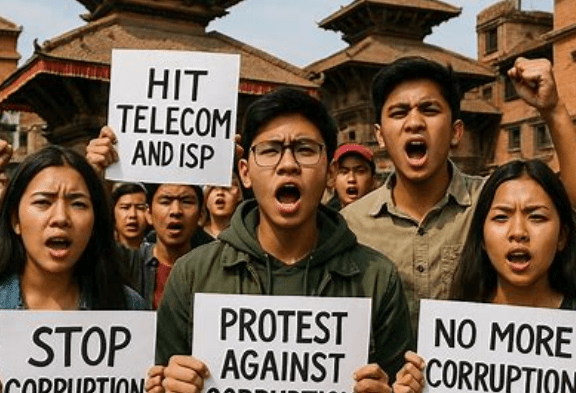Nepal Gen Z Protest Hit Telecom and ISP Infra
The recent Gen Z protests in Nepal have had far-reaching consequences, not only in the political sphere but also in the country’s telecom and ISP infrastructure. Fires, vandalism, and destruction during the demonstrations damaged towers, underground cables, and distribution lines—leaving millions of users struggling with unreliable connectivity.
Disruptions in Telecom Services (NTC & Ncell)
Among the most affected were the two major telecom operators—Nepal Telecom (NTC) and Ncell. Both providers reported interruptions in their mobile and internet services. Several Ncell base stations were damaged, leading to weak signals and call drops in affected districts. Similarly, NTC’s 4G coverage was disrupted in multiple urban and rural areas due to damaged towers and power supply interruptions.
For ordinary users, this meant missed mobile banking transactions, disrupted online classes, and interrupted access to essential communication channels. For businesses, it resulted in delayed digital transactions and productivity losses.
Internet Outages for ISPs (WorldLink, Vianet, Subisu)
The biggest challenge was faced by Internet Service Providers (ISPs) in Nepal. Companies like WorldLink, Vianet, Subisu, and Classic Tech reported outages after fiber-optic cables were cut or burned in protest-hit areas. Residential users in Kathmandu and Pokhara faced hours without internet, while corporate clients—including IT companies, fintech firms, and call centers—suffered workflow breakdowns.
For example, WorldLink internet services in Kathmandu were down in several neighborhoods, frustrating home users. Subisu also struggled to restore connections as damaged street-side distribution boxes required physical replacement. These issues highlighted how dependent daily life in Nepal has become on reliable ISPs.
Exposing Nepal’s Digital Vulnerability
The protests have exposed Nepal’s fragile digital backbone. Despite years of investment in 4G expansion and nationwide fiber connectivity, both telecom and ISP networks remain highly vulnerable to unrest and disasters. Power outages, limited backup systems, and delayed repair work showed that the system lacks the resilience needed for a stable digital economy in Nepal.
The Way Forward
To safeguard Nepal’s digital future, telecom operators like NTC and Ncell, and ISPs such as WorldLink, Vianet, and Subisu, must prioritize:
- Underground fiber deployment with stronger protection.
- Smart monitoring and automated alert systems.
- Disaster recovery sites to handle large-scale outages.
- Community-level collaboration for protecting infrastructure during unrest.
For policymakers, these events underline the urgency of prioritizing digital security in Nepal’s ICT sector. Stronger regulations, incentives for infrastructure protection, and public-private partnerships are essential if Nepal is to become a resilient digital nation.
Conclusion
The Gen Z protests in Nepal were more than just a political movement—they were a wake-up call for the country’s digital ecosystem. The damage to NTC, Ncell, WorldLink, Vianet, and Subisu networks shows that reliable telecom and ISP infrastructure is not just a convenience but a national necessity. Strengthening resilience now will ensure Nepal’s future as a secure and thriving digital economy.




